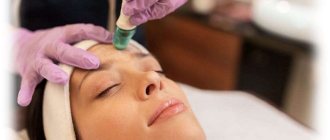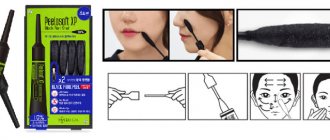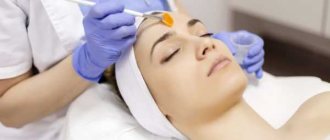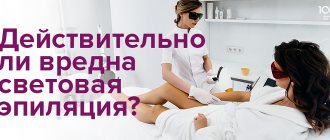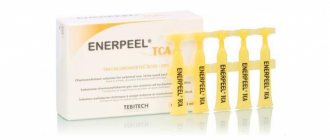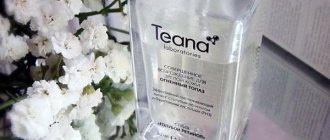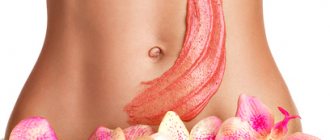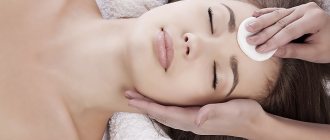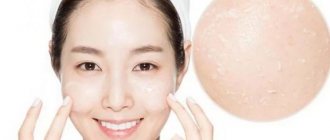From this article you will learn:
- Why peeling in summer can harm your skin
- Who is peeling recommended for in summer?
- What are the contraindications for peeling procedures in summer?
- What types of home and professional hardware peeling can be done in the summer?
- How to care for your skin after peeling in summer
Velvet and silky skin is the dream of every woman. Representatives of the fair sex often use a common cosmetic procedure - peeling. It renews the skin, the body begins to breathe, the dermis is transformed. After the manipulation, you can get an even complexion, lightening of age spots, cleansing and narrowing of pores. To avoid losing the effect, repeat cleaning regularly. Is it possible to do peeling in the summer and what the consequences of this procedure may be, you will find out in this article.
Self-healing of the skin is the secret.
Exfoliation is one of the most popular procedures for a very simple reason. Its high effectiveness is based on the natural mechanism of epidermis rejuvenation, when old layers are replaced by new elastic and elastic cells.
Not many organs in our body can heal themselves, the skin is one of them. This unique ability is used when exfoliating.
The secret to the effectiveness of exfoliation is the natural ability of the epidermis to renew itself.
Update mechanism. In the basal layer of the epidermis, this is the lowest layer of the five components of the epidermis, keratinocides are formed. During their life, they move upward. Along their life path, from the basal layer to the stratum corneum, keratinocides change. Gradually, life leaves them and in the stratum corneum they are already dead corneocytes, the connections between them are destroyed and natural exfoliation occurs.
Old cells of the epidermis, like dried out, last year's foliage, gray and earthy. The allegory is more true for aging, aging skin.
Superficial peeling comes down to speeding up the natural exfoliation process by removing keratinized cells, the same keratinocides in youth that turned into corneocytes in the stratum corneum.
The only way we help this natural function is to remove dead skin cells during superficial exfoliation, without waiting for their natural exfoliation. Mother Nature does the rest. Instead of deleted ones, qualitatively new ones appear.
- Peeling starts the rejuvenation process.
- The destroyed upper stratum corneum “gives a signal” to the lowest, basal layer - it’s time to act, it’s time to renew itself.
The mechanism is described in a simplified manner, many details are missing. The description is given only to understand what underlies exfoliation and why it works. You can read more about the structure of the epidermis in the article - Structure of the skin, epidermis.
This article will not discuss hardware methods of exfoliation that are used in beauty salons and medical centers. The article discusses home methods of peeling for the summer season.
Having excluded hardware methods from consideration, we will focus our attention on chemical and mechanical exfoliation.
What skin problems that arise in summer can peeling help cope with?
Pigment spots are the most common problem that occurs in summer. Peeling with fruit acids will help lighten blemishes, reduce the intensity of freckles and even out skin tone. But remember that aggressive cleansing and improper post-peeling care can, on the contrary, cause severe pigmentation. A well-done procedure promotes an even tan.
In the summer, the sebaceous glands work more actively, the skin becomes oily, and the pores become clogged. Peeling helps cleanse the skin of blackheads and acne, tighten pores, even out the texture and normalize the functioning of the sebaceous glands.
Depth of impact – safety and effectiveness.
Before talking about the types of exfoliation, it is necessary to understand the depth of impact at which peeling is carried out. To do this, let's get acquainted with the structure of the epidermis. This will help you understand how peels differ in depth of impact and risk of side effects.
There are only 5 layers in the epidermis, all of them differ in the vital activity of cells and their functionality. Cells become less vitally active from the lowest basal to the highest horny.
The topmost layer is the stratum corneum. Consists of keratinized particles and dead cells. The second one from the top is shiny. Well developed on the soles and palms, the cells are not as dead as in the stratum corneum, but not alive compared to the next layer. The next one is grainy. In structure and composition of cells, it differs from the shiny and horny ones. The main function is to create a protective barrier. Next, prickly. Here the conversion of keratinocides into corneocytes begins, and lipid synthesis also begins. And finally, basal. In this layer, the generation of cells occurs, which at the end of their journey will turn into keratinized particles.
Types of peelings by depth.
Superficial - affects only the stratum corneum. This type is used in the summer; we’ll talk about it in more detail a little later. The most delicate, but also less effective.
Median - works with living epidermal cells that are deeper than the horny one, but does not affect the basal one. The impact is deeper, the effectiveness of use and the possible risks of side effects are higher.
They are used as active chemical components.
- Trichloroacetic acid.
- Salicylic acid in high concentration.
- Azelaic acid.
- Retinol.
Deep – works throughout the entire depth of the epidermis of the barrier. High efficiency with relatively high risks of complications. This type is given in medical centers.
Phenol is used for deep chemical peeling.
Why is it undesirable to carry out procedures in summer?
Let's remember what peeling is - it is cleansing the skin from the upper stratum corneum, which acts as a natural protection and barrier from dirt, dust, and UV rays. Therefore, the procedure solves many cosmetic problems:
- deep cleansing;
- acne prevention;
- skin smoothing and scar treatment;
- skin lifting;
- good penetration of active components of cosmetics.
On the other hand, the exposed dermis easily becomes dry from the sun and becomes susceptible to ultraviolet radiation. The tan comes in patches, and it is extremely difficult to even it out later.
The process of photoaging (deterioration of tone due to dryness and high sensitivity to ultraviolet radiation of the middle and deep layers of the skin) occurs more actively. This applies not only to direct tanning, but also to reflected rays.
Therefore, during active sunshine, you should avoid deep and medium cleansing, laser procedures and many beauty injections. Many of their components increase the sensitivity of the skin to the insidious and gentle luminary.
Here it is worth understanding that the calendar summer and the real one do not coincide in a number of regions: in the south the “dangerous” period is longer, but the need for care is no less. What to do?
The dark side of exfoliation.
Exfoliation is a controlled injury. The skin becomes vulnerable to external influences, especially to ultraviolet radiation, which is most active in summer. The deeper we act, the more defenseless the skin. Therefore, the question arises whether or not to do summer facial peels when the sun is at its maximum.
If you exfoliate incorrectly, you can get even more pigmentation or other complications instead of correcting age spots.
Deep peelings are strictly not recommended in the summer; medium peels are not recommended (some sources suggest the possibility of carrying out these procedures in the summer). Superficial is possible, but under certain conditions.
Let's summarize. Of the peels used in summer, without the risk of side effects, only superficial peels can be used.
The main problem of summer peelings is solar activity.
Recovery period
After a gentle salon cleansing, there is no need to adhere to serious restrictions. At the same time, the basic rules fit well into the regular care program:
- Use day creams or products with SPF20 or higher.
- Do not forget about regular cleansing, moisturizing and nutrition, using softer options.
- In the first days (preferably a week or two), avoid active sun, use sunglasses and a wide-brimmed hat when outdoors.
- Also temporarily refrain from temperature contrasts (bath-sauna).
Of course, you need to avoid unhealthy treats that contribute to dehydration.
Get into the healthy summer habit of using cosmetic moisturizing sprays or simply purified water from a spray bottle. In hot weather, this is a great option to refresh your skin.
Summer facial peels are not scary if you know which ones.
In summer, it is possible to carry out only superficial cleansing, using.
- Peels with fruit acids (AHA).
- Enzyme peelings.
- Scrubs.
Characteristics of summer exfoliation.
- The composition includes fruit acids with small molecules and unable to penetrate deeply.
- They have a “soft” effect.
- Acid concentration no more than 10%.
- Application does not cause sensitivity to the sun.
- To obtain results, a course of several procedures is required.
- The impact of summer peels is limited to the stratum corneum and no deeper.
Conventionally, they are classified as summer acids.
- Almond.
- Dairy.
- Wine.
- Lemon.
- Apple.
No matter how delicate the effect of summer peeling is, it is inherently traumatic. Therefore, it is important to understand both contraindications to the procedure and the need for post-peel care.
Contraindications to the use of peelings.
- The presence of injured areas, wounds, cuts, etc., as well as the presence of active inflammation.
- Cuperosis depends on the degree. Sometimes peeling is recommended, but not in the summer and a consultation is required.
- Recent procedures involving disruption of the skin (invasive).
- Acute skin diseases, allergic diseases.
- Having a recent tan.
- Taking medications that weaken the immune system or increase sensitivity to solar radiation.
Let's summarize. In summer, you can use exfoliation based on fruit acids of a certain concentration. But that is not all.
When is it okay to agree?
Some types of cleansing are superficial, quite gentle and help reduce sensitivity to UV rays. And these are the types of peeling that can be done in the summer. Cosmetologists recommend these measures:
- For those with oily and problematic skin, when regular care does not provide the necessary cleansing.
- If you are prone to acne and rosacea.
- For rapid tissue scarring and treatment of fresh marks.
- For seasonal peeling, sagging skin, gray and uneven complexion.
According to experts, such procedures are tolerated quite well even by fair-skinned people, who burn quite quickly in the sun and are forced to use SPF protection regularly.
What to do before and after peeling.
A prerequisite for any exfoliation is compliance with the relevant recommendations.
- Active exposure to sunlight should be avoided for 2 weeks before exfoliation.
- During the same 2 weeks, use washes with acids. This will allow the skin to adapt. The impact of washes is not so aggressive
- Do the procedure in the evening.
- After exfoliation, a neutralizer may be a good idea. This product contains alkali and soothing components that neutralizes the effects of acid.
- After peeling, apply SPF cream with a factor of at least 30.
- And also, use cosmetics - moisturizing, nourishing, restoring or soothing the skin. For example, an active mask. Instead of a mask, you can use a restorative or nourishing cream.
- Avoid direct sunlight.
When not to do it
- Sensitivity and allergies to certain drugs.
- Acute viral and infectious conditions (both on the skin of the face and internal), active pustules.
- Hormonal changes and instability.
- Pregnancy and breastfeeding (as an option for hormonal changes, when the skin reaction is unpredictable).
These conditions affect the receptivity and recovery of the dermis after any cosmetic procedures.
It’s worth making adjustments if you love sunbathing: after active sunbathing, it’s better to wait 7-10 days for the body to recover a little and for the cleansing to be effective and beneficial.
Enzyme peels are the best summer peels.
The principle of action of enzymes is the same as that of acids. They destroy the substances that hold the scales of the stratum corneum together. But the effects are so delicate that enzymes are used for sensitive types and for rosacea.
Main characters.
- Papaya extract.
- Pineapple extract.
General recommendations for the use of enzymes. From a physics course we know that the activity of substances increases with increasing temperature. Therefore, advice - after applying the composition to your face, wet your hands with warm water and massage for a few minutes, the activity of papaya and pineapple will be higher.
From theory to practice - Enzyme peelings from Cell Fusion, a well-known brand of professional skincare cosmetics.
Peeling for deep soft cleansing Gentle Deep Powder Wash Cell Fusion C, 70 gr. Basic care with an emphasis on deep cleansing. Provided with a unique composition of a patented complex of lipid barrier strengthening NEO-CMS and papaya enzymes, also contains fermented pollen extract, collagen and cactus extract.
Enzyme cleansing peeling Papaya Granule Peels, 50 gr. - a unique composition of: papaya enzymes, allantoin, corn starch and lactose provide an exfoliation effect and hydration.
Scrubs are all about the tiny bit.
Peeling and scrub differ in their active ingredients. In one, the working agents are acids or enzymes, in the other, abrasive particles are used. But they have only one object of influence, these are keratinized scales. Therefore, an alternative to summer exfoliation is a scrub. The abrasive particles of the scrub may be different. These can be natural or synthetic particles. Natural doesn't mean best. Synthetic beads exfoliate more gently and can be used even on dry or sensitive skin.
The key difference between synthetic particles is no longer an abrasive effect, but a delicate grinding that eliminates micro damage.
When comparing scrubs and peels, it's more a matter of personal preference. When using chemical exfoliation, the degree of irritation depends on the individual perception of acids, their type, and the degree of their concentration. Those. The number of factors and uncertainties that need to be considered when choosing a chemical exfoliator is greater compared to a scrub. On the other hand, acids have additional impact factors that scrubs do not have.
From theory to practice - Exfoliating products from Obagi ZO Skin Health, a well-known brand of professional skincare cosmetics.
Dual action scrub, 116 g. - a unique composition of: patented complexes, delicate scrubbing elements (synthetic wax, candelilla wax), AHA and BHA acids (salicylic and lactic).
When using scrubs, you must keep the following in mind. Do not use scrubs for irritated and inflamed skin, as well as for rosacea.
Doctor
Diana Demidion
The chief physician of the clinic "Academy of Cosmetology Premium Aesthetics" with 11 years of experience,
Diana Vitalievna Demidion, dermatologist and chief physician of the Academy of Cosmetology, gave a long interview about the features of performing hardware procedures in the summer.
“Despite the fact that, actively moving around the world, many patients experience increased ultraviolet exposure throughout the year, it is with the onset of the spring-summer season in Russia that the fear of hardware cosmetology greatly increases.
Is it possible to do hardware procedures in the summer?
Concerns about the use of phototherapy and laser therapy during periods of increased insolation are most often unfounded. However, not only many patients, but also cosmetologists still believe in this stereotype. A couple of decades ago, when technologies in aesthetic medicine were not yet at such a high level, hardware procedures in the summer could actually cause post-traumatic pigmentation.
Now the success of therapy depends entirely on the qualifications of the specialist. If you follow the protocols for carrying out the procedure in the summer, the rules of preparation and proper rehabilitation, even when using ablative lasers, you can achieve a good effect without the risk of complications.
Are there procedures that are best postponed until the fall?
Almost all hardware facial procedures can be performed in the spring and summer. There are patients who need therapy at any time of the year for dermatological reasons. For example, people with exacerbation of rosacea or emotional dermatosis. Phototherapy is one of the safest technologies that can, and in the case of complex patients, even need to be continued in the summer. Over my many years of practice, there have never been cases of post-traumatic hyperpigmentation after IPL therapy.
If we talk about carrying out more traumatic procedures, then if safety precautions are not followed, they can cause complications even in winter. Following all protocols, we at the Premium Aesthetics Academy even carry out aggressive treatments, such as CO2 laser resurfacing in the summer, without risk to the patient.
Here you can rely on the experience of Western colleagues, for example, from the USA, for whom modern technologies allow them to carry out aggressive laser procedures all year round, even for patients with phototype IV.
The only exception to the list of permitted cosmetic procedures in the summer is phototherapy of existing pigment formations. In order not to worsen the condition of patients, for example, with melasma, we send them home until September-October, while prescribing maintenance therapy:
- Cosmetology treatments;
- Lightening agents for external use;
- Taking micronutrients.
What should we do for patients with hyperpigmentation who, for a number of reasons, are exposed to increased insolation all year round?
Treatment of such patients will be complex and difficult to predict at any time of the year. For example, after a course of lightening phototherapy in the fall or winter, pigment formations may disappear completely, and when the patient is exposed to ultraviolet radiation, they may appear again, but they will be much lighter than before treatment.
In this case, phototherapy can be considered successful. For people suffering from hyperpigmentation and often visiting warm countries, procedures are carried out between flights at infrequent intervals, and during the breaks they are prescribed topical products and drugs that reduce the production of pigments.
What other options for performing hardware procedures in the summer are there?
First of all, this is a huge range of body treatments:
- Scar correction;
- Elimination of burn marks;
- Resurfacing of stretch marks and stretch marks.
Such therapy, as a rule, lasts quite a long time and can take from a year to two. There is no point in wasting time and interrupting it for the spring-summer period due to unfounded fears. The body is protected by clothing even in summer; if you additionally use sunscreen, the risk of post-traumatic pigmentation will be minimal.
What measures will help keep patients safe?
First of all, this is high-quality patient preparation, which includes:
- Analyzes for micronutrient content and amino acid imbalance;
- Taking medications that reduce melanin production a month before the start of a course of hardware cosmetology;
- Lightening biorevitalization course;
- Procedures aimed at increasing skin hydration.
It is equally important to follow the rules of rehabilitation:
- Ideally, 7 days, but at least 2-3, do not appear in the sun;
- Use sunscreen with SPF of at least 50;
- Carry out procedures that accelerate skin restoration. For example, in my practice, 2 weeks after laser resurfacing, I recommend phototherapy to patients on M22, which has a protective effect and reduces inflammation;
- Do not neglect cosmetic care: depigmented peelings and biorevitalization.
Failure to follow the recommendations of a cosmetologist during the summer can provoke the appearance of post-traumatic hyperpigmentation.
What else can cosmetology offer?
In spring and summer, we try to exclude techniques that provoke inflammation, for example, deep peels. Instead, the emphasis is on preventing photoaging and the formation of pigmentation with the help of antioxidant agents. During this season, healing and brightening serums can be safely used in combination with ultrasound to improve skin permeability. All modern types of RF lifting, mesotherapy with preparations based on hyaluronic acid and superficial acid peels are carried out safely.
In care, it is recommended to use products with amino acids and peptides that stimulate the functioning of fibroblasts.
Thus, most procedures using devices can be safely performed in the spring and summer if the patient is prepared in advance and the rehabilitation recommendations are followed.”
